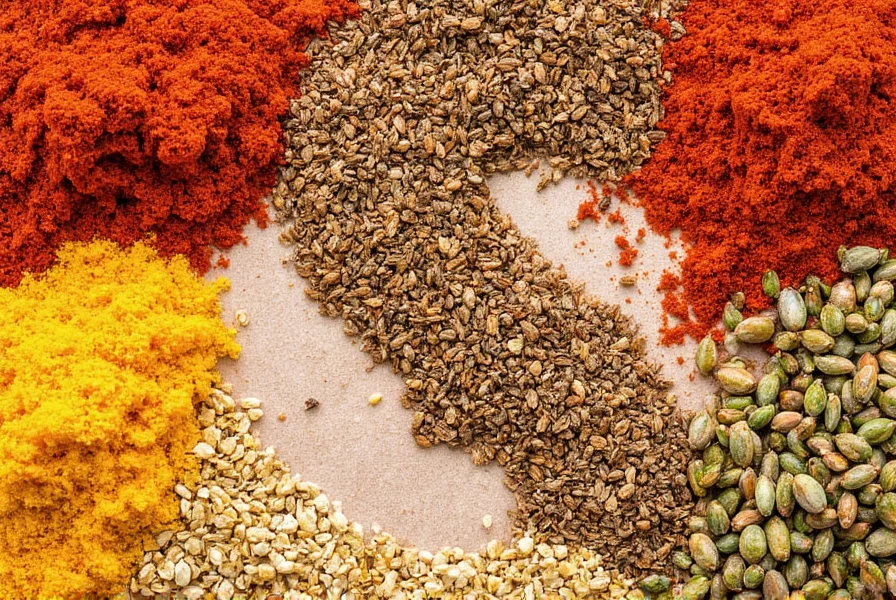Discover the top 7 spices starting with S that every kitchen needs. This guide provides clear, actionable information on each spice's uses, storage tips, and how to choose the best quality for your cooking needs.
| Spice Name | Key Uses | Flavor Profile |
|---|---|---|
| Star Anise | Braises, pho, desserts | Sweet, licorice-like |
| Sumac | Salads, grilled meats, hummus | Tart, citrusy |
| Saffron | Paella, risotto, desserts | Floral, honeyed |
| Szechuan Peppercorns | Stir-fries, hot pots, chili oil | Numbing, citrusy |
| Smoked Paprika | Chorizo, roasted veggies, sauces | Smoky, sweet |
| Savory | Bean dishes, stuffing, grilled meats | Peppery, herbal |
| Sesame Seeds | Breads, stir-fries, tahini | Nutty, buttery |
1. Star Anise – The Sweetly Fragrant Powerhouse
| Form | Pros | Cons | Best Use |
|---|---|---|---|
| Whole | Potent aroma, reusable in some dishes | Can be too strong if overused | Braises, soups, poaching liquids |
| Ground | Easier to blend into rubs and sauces | Loses flavor faster | Desserts, spice blends, marinades |
2. Sumac – Tangy and Vibrant Citrus Kick
- Sprinkle over hummus or labneh for a zesty finish
- Add to grilled fish or chicken for a fresh kick
- Mix into olive oil and drizzle over avocado toast
3. Saffron – The Golden Luxury
| Grade | Description | Use Case |
|---|---|---|
| Grade I (Long threads) | Ruby-red threads, minimal white parts | Fine dining, special occasions |
| Grade II (Shorter threads) | Mixed color, moderate quality | Everyday cooking |
| Grade III (Powdered mix) | May contain stamen pieces, less aromatic | Cheap alternatives, bulk recipes |
4. Szechuan Peppercorns – Tingling Taste Explosion
- Toasting enhances the citrusy notes
- Grind with salt to preserve oils and potency
- Pair with chili flakes for classic mala (numbing + spicy) flavor
5. Smoked Paprika – Earthy, Sweet, and Deep
| Type | Flavor Intensity | Heat Level | Recommended Use |
|---|---|---|---|
| Sweet (Pimentón Dulce) | Mild, sweet-smoke | None | Stews, rice dishes |
| Bittersweet (Pimentón Agridulce) | Medium smoke | Low | Meat rubs, potato dishes |
| Hot (Pimentón Picante) | Strong smoke | High | Chili, sausage making |
6. Savory – Herb of Many Faces
| Variety | Flavor Strength | Texture | Best Use |
|---|---|---|---|
| Summer | Mild, grassy | Soft stems | Fresh garnishes, lighter dishes |
| Winter | Stronger, more intense | Woody stems | Slow-cooked meals, pickling |
7. Sesame Seeds – Nutty and Versatile Staple
| Type | Flavor | Appearance | Best Use |
|---|---|---|---|
| White | Milder, sweeter | Light color | Baking, sauces |
| Black | Stronger, more aromatic | Dark, striking | Garnish, Korean dishes |
Frequently Asked Questions About Spices Beginning With S
What's the most versatile S-spice for everyday cooking?
Smoked paprika is the most versatile S-spice. Its smoky-sweet flavor enhances eggs, roasted vegetables, meats, and sauces. The sweet variety (Pimentón Dulce) works in most dishes without heat.
Which S-spices are commonly confused with each other?
Star anise and anise seed are often mistaken (star anise is stronger and used whole). Szechuan peppercorns are confused with black pepper but create a numbing sensation instead of heat.
How long do S-spices last before losing potency?
Ground spices: 6-12 months. Whole spices: 1-2 years. Saffron: several years when stored properly.
What are common mistakes with S-spices?
Using stale spices, adding saffron directly to hot oil, overusing star anise, not toasting Szechuan peppercorns, and using the wrong smoked paprika type.
Can I substitute one S-spice for another?
Sumac: lemon zest + paprika. Star anise: anise seed or fennel seeds (different flavor). Saffron: turmeric + paprika (for color only). Szechuan peppercorns have no true substitute.
Which S-spice offers best value?
Sesame seeds (inexpensive, versatile). Sumac (a little goes far). Saffron (small amounts needed for special dishes).
Buying Guide: How to Choose the Best Spices Beginning With S
- Buy airtight containers to preserve freshness
- Avoid transparent jars unless stored in dark places
- Choose whole spices when possible for longer shelf life
- Shop at local spice stores or trusted online retailers like Penzey's
- Store away from heat, light, and moisture; replace ground spices every 6 months
Conclusion: S Is for Seasoning, and So Much More
From the sweet complexity of star anise to the electric tingle of Szechuan peppercorns, these seven spices transform ordinary dishes into culinary masterpieces. Stock up on sumac for citrusy brightness, smoked paprika for smoky depth, and sesame seeds for nutty versatility. With these S-spices, you'll always have the tools to create bold, flavorful meals.











 浙公网安备
33010002000092号
浙公网安备
33010002000092号 浙B2-20120091-4
浙B2-20120091-4